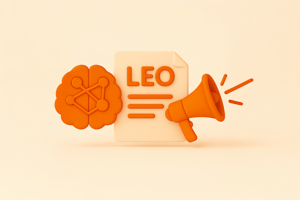
LEO: Language Engine Optimization
Many pieces of content are visible. Very few are citable. That’s exactly what makes the difference in the age of ChatGPT, Gemini, and Perplexity. Language models don’t read websites from top to bottom. They analyze fragments, recognize patterns, check sources, and generate answers from them. The real question is therefore not how well your content performs, but whether it is understood at all.
LEO stands for Language Engine Optimization. It refers to the targeted optimization of content for large language models such as GPT-4, Gemini, or Claude. These models do not function like search engines. They work semantically, contextually, and without fixed rankings. Relevance does not arise from position, but from meaning.
The mindset changes and with it the content model
Until now the rule was: if you wanted to rank high in search engines you needed technical cleanliness, keyword focus and backlinks. This logic was stable for a long time. But LLMs like Gemini or ChatGPT do not follow a scoring rulebook. They weigh content based on context, clarity and credibility.
This has consequences for everyone aiming to generate reach with content. It is no longer just about visibility in the classic sense, but about meaning in the right moment. It is about integration into answers. It is about reliability for systems that do not measure clicks but linguistic coherence.
LEO is not a new tool, it is a shift in perspective
Anyone creating content for websites or campaigns today must ask a new guiding question:
Will this content be understood by an AI, judged as meaningful and potentially integrated into an answer?
This question brings changes not in technology but in editorial work. It is not about relevance for machines, but about clarity for models that truly interpret language.
What defines LEO
-
Content must be modular. Every paragraph should be readable and usable on its own.
-
Headings need semantic precision. They must clearly define what the section is about.
-
Terms, places, names and brands should be explicitly mentioned. This helps AI systems classify the content.
-
Context matters. What comes before, after and around influences whether something is understood.
-
Sources and authors should be identifiable. Language models check who they can trust.
LEO does not think of content in terms of visibility but in terms of usability for machines that generate language. Google SGE analyzes exactly these structures to select content for AI overviews. Gemini goes one step further and combines structured data, semantic understanding and source comparison to create complex multimodal answers.
Why LEO is especially important in B2B
In B2B markets it is often not about massive reach but about credibility. Decision-makers are not looking for marketing fluff, they want expertise. Language models are becoming a new and vital link in the chain between research and decision-making.
Those who succeed in entering this dialogue with their content will not only be visible but also relevant. LEO ensures that content is not overlooked but understood and integrated. Complex products, technical services or intricate processes particularly benefit from this approach.
If a paragraph from your website one day becomes the answer to a specific professional question in ChatGPT or Gemini then LEO has succeeded.
Three central principles for better content in the LEO context
-
Structure beats style
Good content needs order. One idea per paragraph, clear subheadings and a logical flow. Language models do not analyze stylistic devices but semantic relationships. -
Context beats keyword
AI systems recognize connections. Relevance comes not from repetition of terms but from the logic between statements. Thematic depth is therefore more important than search volume. -
Authority comes from clarity
What is well explained is cited more often. This is especially true for content that not only informs but makes a topic tangible. Clear statements, understandable language and transparent attribution increase the chances of appearing in AI-generated answers.
Strategic benefits of LEO for companies
-
Higher chance of appearing in chat answers and AI research
-
Sustainable development of semantic brand presence
-
Greater relevance in the context of expert questions and decision-making processes
-
Clear competitive advantage over content aimed only at rankings
-
Visibility in AI overviews of Google SGE, Gemini and other systems
B2B content thus becomes not only more discoverable but also more intelligently usable. LEO creates compatibility with new information systems that are already part of decision-makers’ daily lives. It is most effective when content is not isolated but bundled within a central content hub. How companies can use this to sustainably strengthen their visibility and position themselves as trustworthy expert sources for AI systems like ChatGPT or Gemini is explained in the article “From Expert to Thought Leader with the Content Hub.”
Questions every website operator should ask today
-
Which content on your website is citable?
-
Which statements are clear enough to stand on their own?
-
Where are subheadings missing that could structure topics meaningfully?
-
Are your author profiles complete, recognizable and trustworthy?
-
Are your contents currently represented correctly by tools like ChatGPT, Gemini or Perplexity?
These questions matter more than any ranking analysis. Because visibility in the traditional sense is no longer a guarantee of discoverability in AI systems.
Conclusion: Visibility comes from clarity
LEO does not change what is said, it changes how.
Those who structure their content clearly, phrase it in an understandable way and prepare it for machine readability are not only relevant for people but also for the systems that will decide tomorrow’s answers. Tools like Gemini, ChatGPT or Google SGE draw directly on such content when generating responses.
If you want to know whether your content is LEO-compatible we will be happy to test it together. Without buzzwords and with a focus on real impact.
FAQ
